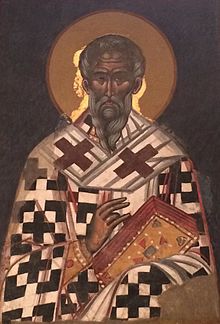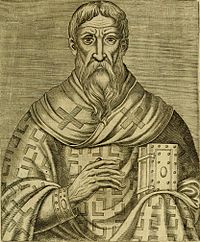
Back پسيودو ديونيسيوس ذا اريوپاجيت ARZ Psevdo-Dionisi Areopagit Azerbaijani Псевдо-Дионисий Ареопагит Bulgarian Pseudo-Dionís l'Areopagita Catalan Pseudo-Dionysios Areopagita Czech Pseudo-Dionysius Areopagita German Ψευδο-Διονύσιος ο Αρεοπαγίτης Greek Pseŭdo-Dionizio la Areopagano Esperanto Pseudo Dionisio Areopagita Spanish Pseudo-Dionysios Areopagita Estonian
Pseudo-Dionysius the Areopagite | |
|---|---|
 Icon by Feofan Kritsky | |
| Born | unknown (5th–6th century AD) |
| Died | unknown (5th–6th century AD) |
| Other names |
|
| Notable work | De Coelesti Hierarchia |
| Era | Ancient philosophy Medieval philosophy |
| Region | Western philosophy |
| School | Neoplatonism Christian philosophy |
Main interests | Apophatic theology Christian angelology Christian mysticism |
Notable ideas | Seven Archangels Hierarchy of angels |
| Part of a series on |
| Neoplatonism |
|---|
 |
|
|
| Part of a series on |
| Christian mysticism |
|---|
 |
| Part of a series on the |
| Eastern Orthodox Church |
|---|
| Overview |
Pseudo-Dionysius the Areopagite (or Dionysius the Pseudo-Areopagite) was a Greek[1] author, Christian theologian and Neoplatonic philosopher of the late 5th to early 6th century, who wrote a set of works known as the Corpus Areopagiticum or Corpus Dionysiacum. Through his writing in Mystical Theology, he has been identified as the "progenitor of apophatic or negative theology."[2]

The author pseudepigraphically identifies himself in the corpus as "Dionysios", portraying himself as Dionysius the Areopagite, the Athenian convert of Paul the Apostle mentioned in Acts 17:34.[3][4][note 1]
- ^ Brock, Sebastian (2011). "Pseudo-Dionysius the Areopagite — Gorgias Encyclopedic Dictionary". Gorgias Encyclopedic Dictionary.
- ^ Critchley, Simon (2024). On Mysticism: The Experience of Ecstasy (1st ed.). Profile Books. p. 71. ISBN 978-1800816930.
- ^ "Pseudo-Dionysius the Areopagite summary | Britannica". www.britannica.com. Retrieved 2022-08-09.
- ^ Acts 17:34
Cite error: There are <ref group=note> tags on this page, but the references will not show without a {{reflist|group=note}} template (see the help page).